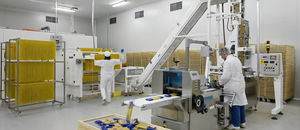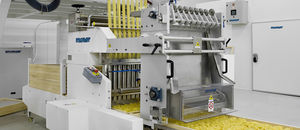
Gluten-free pasta production line dryshort-cutlong-cut
Add to favorites
Compare this product
Characteristics
- Type
- dry
- Shape
- short-cut, long-cut, nest shaped, lasagna
- Other characteristics
- gluten-free
Description
Originally conceived for people suffering from the celiac disease and intolerant to gluten, gluten-free pasta is becoming the synonym of healthy food for everyone, both from the nutritional-physiologic and organoleptic point of view.
Nowadays the market can offer a larger variety of gluten-free products thanks to use of alternative raw materials such as rice, corn, oat, millet, buckwheat, quinoa, amaranth and other thanks to their nutritional properties (more proteins, fibers and mineral antioxidants). Production of gluten-free pasta using gluten-free flours or a mix of the same requires gelatinization of the starch contained in flour in order to obtain an alternative “sticking agent” enabling the dough to become pasta, be cooked and better digested.
The transformation process of the “raw”, gluten-free flour (that cannot become pasta) is called pre-gelatinization treatment.
Gluten-free pasta producers can choose between two alternatives: they can either purchase pre-gelatinized flour (“pregel”) or raw flour (pre-gelatinized) and consequently transform the same by means of the gelatinization process by dedicated system.
As to artisanal and industrial production of gluten-free pasta our company is in a position to customize every project by dedicated technologies, such as use of mixers fitted with special blades and high-performance profile compression screws, particular production techniques, etc.
Catalogs
No catalogs are available for this product.
See all of ITALPAST SRL‘s catalogsRelated Searches
- Pasta forming machine
- Pasta production line
- Stuffed pasta forming machine
- Short-cut pasta production line
- Dry pasta production line
- Long-cut pasta production line
- Ravioli forming machine
- Single dough pasta forming machine
- Ready-meal production line
- Fresh pasta production line
- Lasagna pasta production line
- Pasta production line with cooling
- Pasta production line with drying
- Pasta ready-meal production line
- Pasta extruders
- Double dough pasta forming machine
- Nest shaped pasta production line
- Short-cut pasta forming machine
- Gnocchi forming machine
- Pasta dryer
*Prices are pre-tax. They exclude delivery charges and customs duties and do not include additional charges for installation or activation options. Prices are indicative only and may vary by country, with changes to the cost of raw materials and exchange rates.







